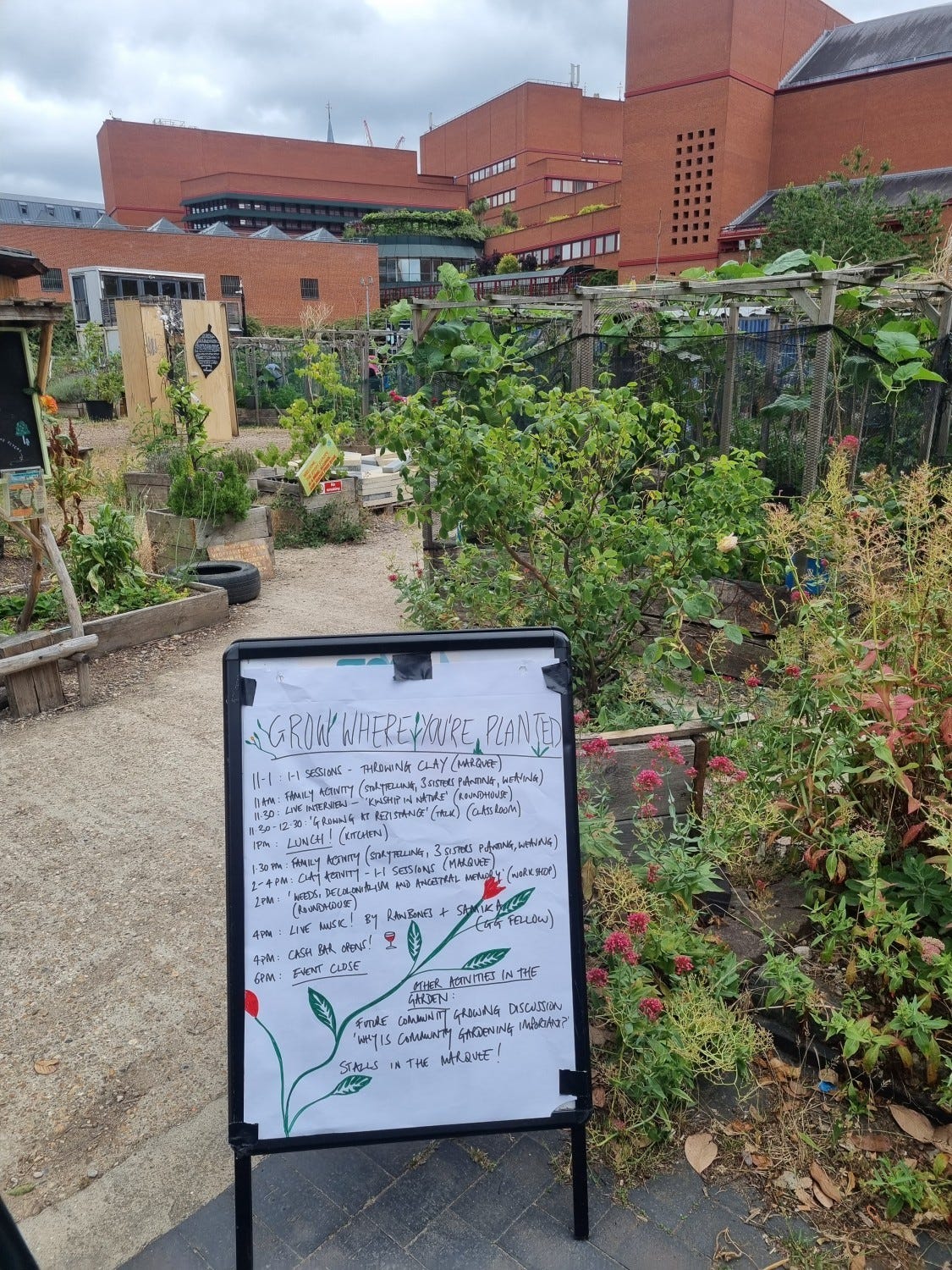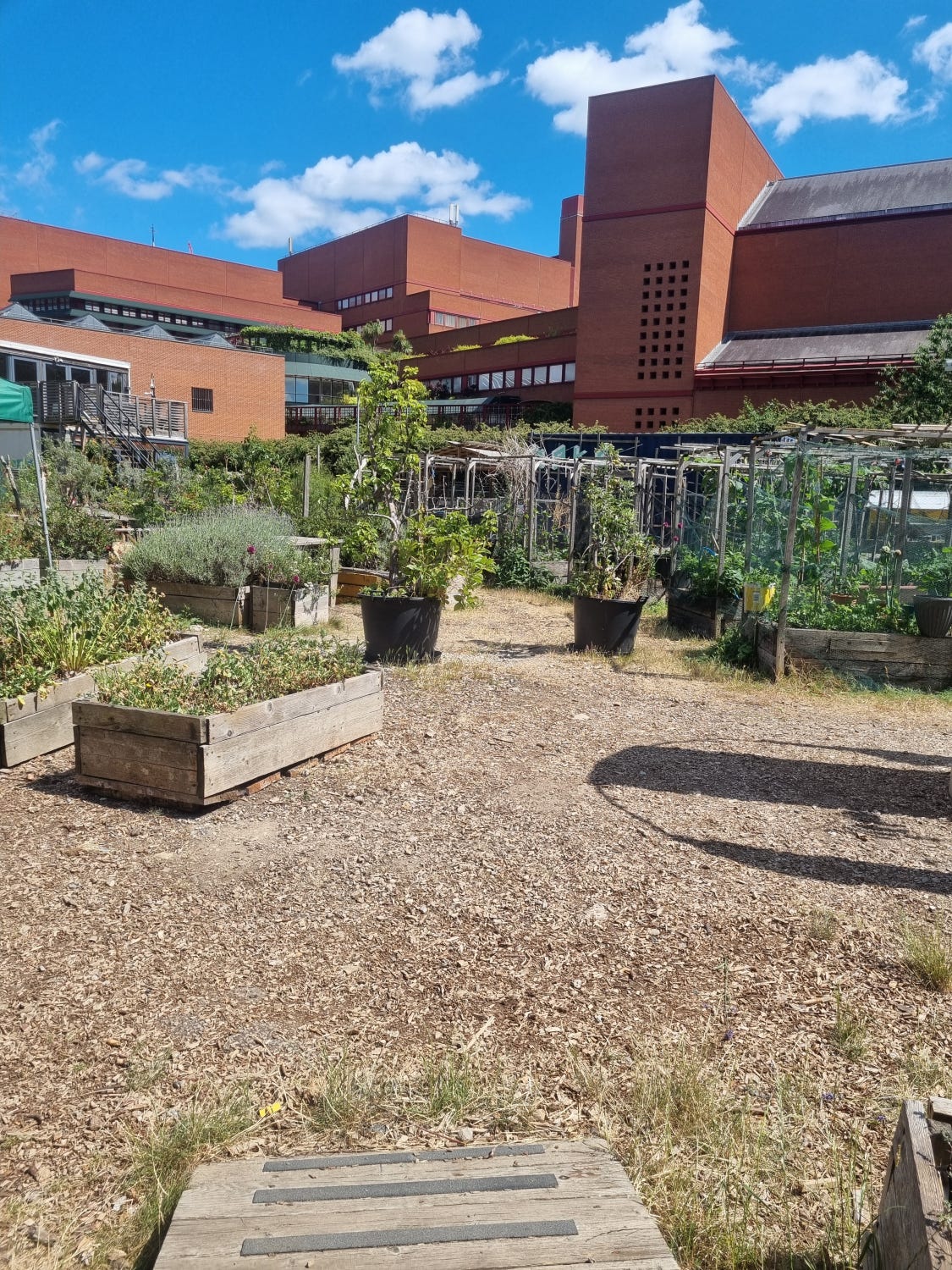What Grows in the Cracks: On Community, Memory, and Designing Otherwise
This weekend I sat in a garden behind the British Library — a once-disused space now transformed into a sanctuary by five years of community care. The Story Garden.
It’s easy to walk past it, toonly a patch of land, tucked away in a city that prizes glass buildings and curated green spaces. But spend a day here, and you’ll feel something ancient stirring. This isn’t just about plants. It’s about presence. It’s about remembering.
This weekend's event, " Grow where you are planted " brought together growers from all over London to celebrate cultural diversity through shared gardening practices and traditions from different communities, while also amplifying voices from historically marginalized communities by spotlighting their contributions to urban gardening, food sovereignty, and community-building. We gathered in circle to talk about weeds, liberation, grief, and ancestral knowledge. We talked about what’s been buried — and what might want to bloom.
Designing with Intention: Beyond the Surface
So often, urban development and social innovation are done to communities, not with them. The Story Garden reminded me that space is never neutral. Every bench, every individual plot, every communal area was shaped with care — by and for community.
It made me reflect on what we mean at Design for Social Impact (DFSI) when we talk about designing for equity. True equity-centred design isn’t just about better outputs or inclusion checklists. It’s about designing in relationship — with land, memory, and people.
Community spaces like the Story Garden aren’t just “nice to have”, they are vital infrastructures of care, memory, and resistance.
In a city where public land is rapidly privatised and communities are pushed to the margins, spaces where people can gather without surveillance, transaction, or exclusion are increasingly rare. Yet these are the very spaces where social ties are built, where intergenerational knowledge is shared, where movements are born.
This is why community co-design in placemaking isn’t a box-ticking exercise — it’s a matter of justice.
Too often, regeneration and development happen to communities rather than with them. This creates disconnection, erasure, and deep mistrust. But when communities are involved from the start , not just as stakeholders, but as designers, decision-makers, and stewards, believe something transformative happens.
Weeds as Wisdom: Reclaiming What Has Been Cast Aside
In one of the workshops, " Weeds, Decolonialism and Ancestral Memories" we were invited to see weeds differently — not as unwanted invaders, but as messengers. Survivors. Signals of what the soil remembers. It felt personal.
Many of us come from communities that have been treated like weeds. Pushed to the margins. Criminalised. Silenced. And yet, like Tupac told us in his poem, "The rose that grew through concrete" just as plants can find their way through concrete, so can we continue to adapt, create, tend, and resist.
This is the lens we hold at Design for Social Impact- design as a site of both resistance and repair. Not neutral. Not apolitical. Design, when done in community, can become a tool to unlearn dominant logics and return to practices rooted in care, reciprocity, and justice.
Ancestral Memory and Designing Otherwise
In the garden, someone asked:
What ancestral knowledge do you carry in your body? In your bones? In your breath?
This question echoed long after I left.
At DFSI, we support community groups, youth, and structurally marginalised changemakers to not just participate in design — but to lead it. To bring their full selves into the room, including the parts that carry memory, land-based knowledge, cultural practices, and spiritual wisdom.
We believe in designing otherwise. Designing beyond urgency, beyond extraction. Designing from the compost — not the blueprint.
This hasn't been an easy pivot for me. After years of working in frontline response, urgency culture and presentism is something I continue to grapple with. But I am realising that when we slow down and listen, so much can grow. Slowing down creates space for healing, for memory and for possibility.
And this garden? It was a live example of what that can look like. A shared space built slowly, collectively, with care. Not for deliverables, but for dignity.
For those of us working in social justice, especially within systems shaped by urgency, extractivism and performance — this raises important questions:
What stories are held in the “weeds” — the people, practices, or histories we've been taught to overlook?
How might we honour ancestral memory and slow time in the ways we gather, build, and evaluate?
What needs to be composted in our practice to make space for something more liberatory to grow?
At Design for Social Impact (DFSI), we work alongside communities to design otherwise, beyond extractive practices, beyond urgency, and beyond tokenism. We support organisations and frontline leaders to centre equity, healing, and collective wisdom in their programmes, policies, and research. Our work includes anti-oppressive design workshops, equity audits, learning journeys, and participatory research trainings — all shaped by and with people most impacted by injustice.
✨ Upcoming opportunities to connect with us:
Book a Mentoring session through our partnership with The Bloom.
Parenting towards Abolition Reading Group ( Free reading group, New Dates to be confirmed!) — exploring anti-oppressive parenting practice.
Design for Social impact (Applications open in August) — for those from marginalised backgrounds looking to co-lead learning spaces.
Research Design for Social Impact (Applications open in September) — rethinking how we measure what matters.
If you’re ready to slow down, reimagine, and co-create liberatory systems, we’d love to be in conversation with you.
#Socialimpact #CommunityLedDesign #LiberatoryPractices #AncestralWisdom #UrbanGardening #DesignJustice #DFSI #Design #HealingSpaces #NothingAboutUsWithoutUs



